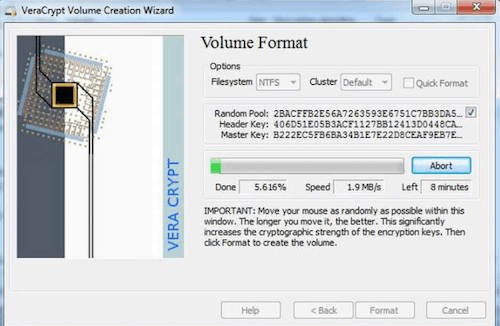

- #Veracrypt cnet how to
- #Veracrypt cnet install
- #Veracrypt cnet update
- #Veracrypt cnet full
- #Veracrypt cnet portable
The most common of these would be the attempt to create a volume name that already exists.

Note this does have one side affect, if there are any errors those too are also suppressed, so you won’t be aware of them. In a scripting situation you would normally not want this, so we add the silent switch to suppress the messages. By default VeraCrypt will display dialogs notifying you of its progress, as well as when it is complete.

#Veracrypt cnet full
It’s a bit more complex than that, if you want full details see the VeraCrypt documentation at:įor now, we can pass it the value of 0, which tells it to use the default value. The PIM is a special number that allows you to specify the number of times the hashing algorithm executes.
#Veracrypt cnet install
Be aware though that to use exfat on a Mac, you’ll have to install macFUSE (see my previous post on macOS for more info).
#Veracrypt cnet portable
In order to keep this container portable across OS’s we’ll format using exfat. Many algorithms require you to provide an encryption hashing method. VeraCrypt supports a vast array of algorithms, see their documentation for the supported list.įor this demo, we’ll use the popular AES. Now we need to provide the encryption algorithm to use. To keep this demo simple, I’m just going to embed the password using the “super secure” password I’ve used throughout this series of blog posts.Īs with file names, if your password has spaces you’ll need to enclose it in double quotes. In a “real world” situation, you should probably pass it into the script or get it using an alternate method. Next up is the password to use to encrypt the volume. If you omit a letter, it assumes bytes.įor this demo we are making it small, so will use 200M to indicate 200 Megabytes. VeraCrypt includes shortcuts for M (Megabytes), G (Gigabytes), T (Terabytes) and We now need to tell VeraCrypt how big to make the volume. Otherwise they are optional, but it doesn’t hurt to have them. If you omit the path it will create the volume in the current directory you are running the script from.Īs with all file names, if it has a space you must include double quotes. You follow it with the path and file name to create. Next is the command to create a volume, /create. "C:\Program Files\VeraCrypt\VeraCrypt Format.exe" Note there is indeed a space in the file name! Thus you have to enclose the entire thing in double quotes. The command to create a new volume is actually a separate executable than the rest of VeraCrypt. It is “ VeraCrypt Format.exe“ "C:\Program Files\VeraCrypt\VeraCrypt Format.exe" /create "C:\temp\vctest.vc" /size "200M" /password MySuperSecurePassword1! /encryption AES /hash sha-512 /filesystem exfat /pim 0 /silentįirst up is the command to call. If you installed VeraCrypt to the default folder, you’ll find it in C:\Program Files\VeraCrypt\ While your blog reader or webpage may wrap the line, in your script (or command line) it should all be entered as a single line of text. Let’s begin by looking at the full command to create a container, then we will break it down to it’s individual components. OK, let’s get started! Creating a Container So for this post we’ll only be able to include creation, mounting and dismounting of containers. One item I want to mention, unlike the macOS version, the Windows version of VeraCrypt lacks the ability to list containers.
#Veracrypt cnet update
I’ll update it over time as needed, and it may be easier for you to download, or cut and paste from it. While I will be providing samples here, you should also check out the project I have on GitHub that goes with this post, VeraCrypt-CommandLine-Examples. If you open up a command window and see PowerShell, all you have to do is type in CMD and it enter, and you’ll be switched to CMD mode. Do note that on most installations of Windows these days, PowerShell has replaced CMD as the default terminal shell. My first post in the series, “ VeraCrypt – A Powerful Encryption Utility“, covers where to get it from.įor this post, we’ll also be using the CMD mode to execute the commands. Obviously, you’ll need to have VeraCrypt installed.
#Veracrypt cnet how to
In this entry you’ll see how to call VeraCrypt on Windows 10. The commands to call VeraCrypt from the command line are very different for each platform, As such, I’ve broken them out into individual blog posts. My previous post, “ VeraCrypt on the Command Line for macOS“, showed how to call VeraCrypt from within a script on the macOS platform. In the second post, “ Creating and Using Hidden Containers in VeraCrypt“, I covered how to create a hidden container, adding an extra level of security to your containers. If you’ve not kept up, in my first post of the series, “ VeraCrypt – A Powerful Encryption Utility“, I covered the basics of VeraCrypt including how to get it, use it through the GUI, and how the series was inspired by the Grumpy Old Bens podcast. This is part of my ongoing series on the VeraCrypt encryption utility.


 0 kommentar(er)
0 kommentar(er)
